Plant-eating bugs are the bane of every gardener’s existence. Not only do they damage the plants physically, but they also affect their overall growth, yield, and health. In worse cases, such as severe infestations, they can even cause death. It’s important to know how to get rid of them to avoid further injury to your plants.
To stop bugs from eating your plants you can use the following methods: Cultural control (modifying gardening practices),
Physical control (placing physical barriers),
Mechanical control (directly removing or killing insects),
Biological control (releasing natural predators), and
Chemical control (using chemicals to inhibit insect feeding or kill them completely).
To know more about common plant-eating bugs, how you can inhibit their feeding or kill them, how you can prevent their potential damage, what possible treatment plans you can do, and other interesting information, read further this article!
Bugs That Eat Plants
Leafminer
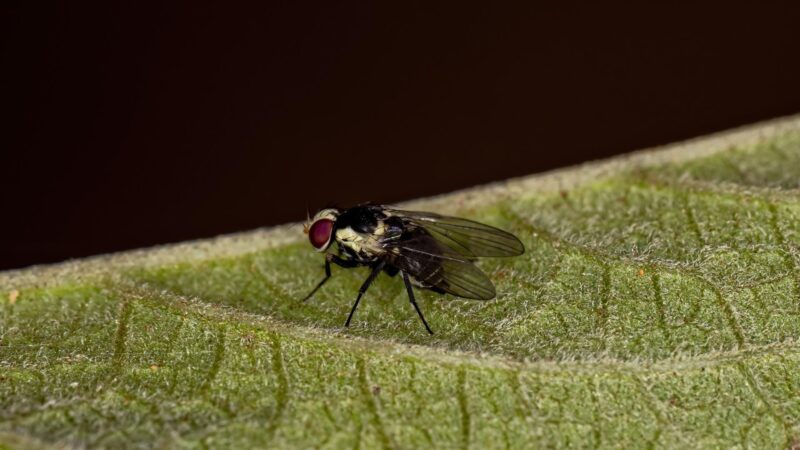
- Scientific Name: Agromyzidae
- Appearance: Varies per species but they are generally tiny flies that are grayish-black in color
- Size: 1 to 2 millimeters
- Diet: Tissue of vegetable plants that also serve as their hosts. This includes beet, leafy greens, spinach, squash, pea, tomato, onion, and eggplant. They also feed on ornamental flowers such as gerbera daisies, chrysanthemums, and marigolds.
- Damage: Leafminer larvae feed their way through the plant’s mesophyll layer, which results in poor photosynthetic performance, a decrease in plant quality and yield, and the drying and dropping of leaves. Additionally, adults create punctures while feeding and laying eggs, particularly on the upper surface of the plant’s leaf. This allows the plant to become vulnerable to fungal and bacterial diseases.
- Control:
- Check signs of leafminer infestations such as live leafminers and white stipplings on the plant, then destroy any infested plants or leaves. Remove plants that are common inhibitors of leafminers such as weeds and ornamentals.
- Place a mesh row cover over your plants that have not been invaded with leafminers for at least a year, to protect them. The cover has to be made of material that can easily be penetrated by sunlight and rain.
- Rotate plantings and apply sufficient irrigation to reduce plant stress and keep them healthy.
How to Get Rid of Leafminers?
Apply low-impact pesticides on slight infestations. Keep in mind that this doesn’t kill the larvae that are already consuming within the plant leaves. However, in case of heavy infestations or if you want to kill the larvae, apply an insecticide.
Squash Vine Borers
- Scientific Name: Melittia cucurbitae
- Appearance: Insects that resemble wasps with scaly front wings, which give them a black to metallic green iridescence, reddish hairs and black dots on their abdomens, and black and orange hairs on their hind legs
- Size: 16 millimeters
- Diet: Vascular tissue found on the stems of their plant hosts, which primarily includes summer squash and pumpkin, but they also feed on cantaloupe, cucumber, and Mexican gourd.
- Damage: Plants start wilting and will eventually collapse and die if they’re left unchecked. They also puncture holes through the plant base and will fill them with a sawdust-like material similar to termites’ frass. This will also cause the base to either become mushy or rot away completely.
- Control:
- Proper sanitation of your yard, garden, or field is important to reduce their populations in the succeeding season. Collect and discard any vines and plants that were killed by the insects.
- Grow plant varieties that are least preferred by squash vine borers, such as Waltham butternut. On existing crops, place a lightweight row cover, but make sure to remove it during the flowering period to allow pollination. When harvesting crops, plow afterward.
- Apply insecticides early in the planting season to immediately kill larvae as they start hatching from their eggs.
How to Get Rid of Squash Vine Borers?
Check your plants for any holes with frass, which may indicate the presence of the insects’ larvae. Afterward, cut any vines lengthwise near the hole, then remove the larvae physically.
Once you’ve done that, cover the stem with soil. You can also apply pesticides on the runners and crowns of the plants but make sure you do it late in the day to not disturb any pollinators.
Aphids
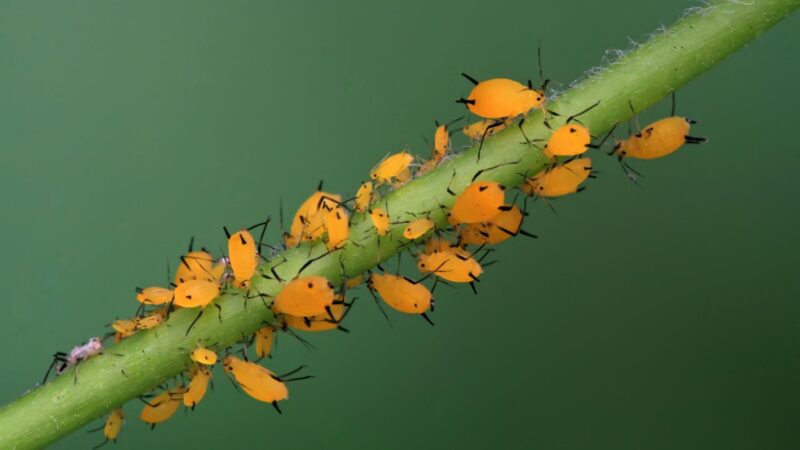
- Scientific Name: Aphidoidea
- Appearance: Tiny insects with bodies that are soft and pear-shaped. They can be a variety of colors, from black, gray, brown, red, yellow, and green. Mature aphids can be both wingless or have wings. Aphids that have wings are darker in color.
- Size: 2 to 4 millimeters
- Diet: They feed exclusively on plant sap found on the underside of young leaves, roots, developing stems, unopened flower buds, bark, and twigs.
- Damage: Aphids feed on plant sap using their thin, needle-like mouthparts. When left untended, aphid feeding can cause yellowed foliage, twisted and curled leaves, stunted or dead shoots, and even poor plant development. They can also cause the growth of sooty mold, which is a fungus, as a result of them secreting honeydew onto the host plant after feeding. Lastly, aphids can carry plant viruses which can infect many vegetable plants.
- Control:
- Remove any weeds in your garden or yard to reduce the areas where aphids can potentially attach. Prune out any dense inner canopies on large trees to make them less appealing for aphids.
- Make sure to not use more nitrogen fertilizer than necessary as they aid in aphid reproduction. If possible, use slow-release fertilizers instead.
- Grow seedlings under protective covers to reduce aphid feeding.
- Release commercially available adult lady beetles for biological control, as they are natural predators of aphids.
How to Get Rid of Squash Aphids?
The most common method of removing aphids immediately is just knocking them off of plants using a high-pressure garden hose. This also helps remove any sooty mold or honeydew present in your plants. You can also use plant-based pesticides, horticultural oils, insecticidal soaps, and pyrethrins to stop aphids from feeding.
Tomato Hornworm
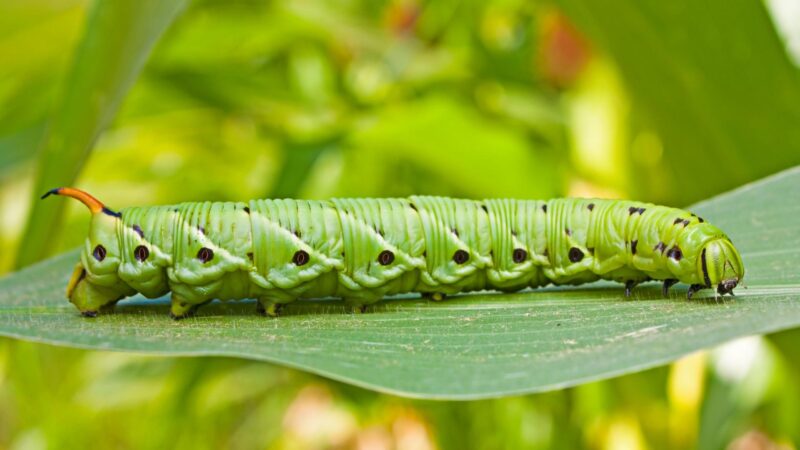
- Scientific Name: Manduca quinquemaculatus
- Appearance: Small tomato hornworm caterpillars are yellow to white in coloration and have no markings, while the larger-sized ones will develop 8 V-shaped marks on each of their sides that are white in coloration. They also have a black horn-like feature on their last abdominal segment.
- Size: Up to 10.16 centimeters
- Diet: They eat the fruits, leaves, and blossoms of tomatoes, which are their primary host plants, but they can also be found feeding on eggplants, potatoes, and peppers. They also prey on weeds such as nightshade, horsenettle, and jimsonweed.
- Damage: Tomato hornworms cause defoliation and scar the fruits of their host plants. They also leave behind black or dark green droppings.
- Control
- Discing and tilling after harvest helps eradicate burrowing caterpillars and pupae found in the soil.
- Crop rotation of plants that are not touched by hornworms will also help reduce the insects’ population densities in individual fields.
- Remove any weeds to reduce the number of potential sites in which the worms can lay their eggs.
How to Get Rid of Tomato Hornworms?
The most effective method would be to manually pick them off of infested plants using soapy water first to kill them and then with gloved hands to remove them. They’re easy to find since they’re large. In most cases, pesticides are unnecessary. However, in heavy infestations, you may consider applying low-risk or residual pesticides.
Earwigs
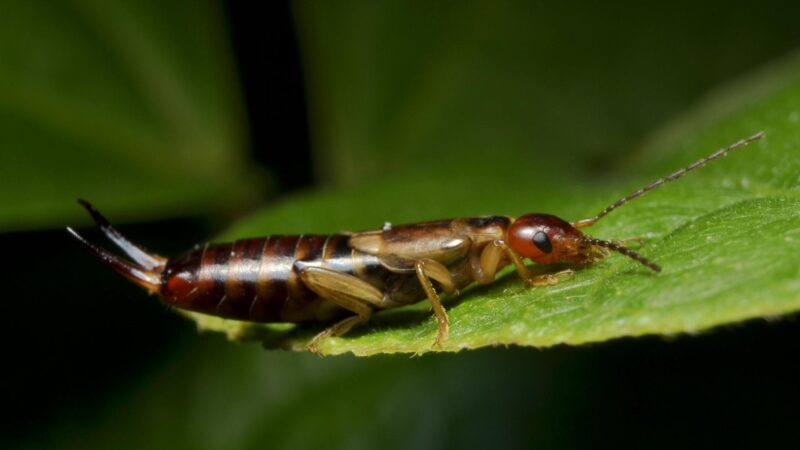
- Scientific Name: Dermaptera
- Appearance: Flat body, medium-sized antennae, chewing mouthparts, and forceps-like pinchers extending from the tip of their abdomen. They are reddish or reddish brown in color.
- Size: 1.6 to 1.9 centimeters
- Diet: They feed on both healthy and damaged or decaying plant matter of flowers, vegetables, and ornamental plants. They also consume dead or weak insects and other smaller-size organisms.
- Damage: Earwigs can be household nuisances as they usually enter homes and buildings in large numbers. Additionally, they release a foul-smelling liquid from their abdomen. They’re also garden pests as they chew holes through flower blossoms and leaves of butterfly bushes, marigolds, hostas, and dahlias. When left untended, seedlings and flowering plants could get damaged or even die.
- Control:
- Sanitize your yards or gardens by cleaning up debris that earwigs can hide under, such as piles of lumber, leaves, bricks, and plant debris.
- Lessen the amount of moisture in your landscapes. Make sure there are sufficient drainage and irrigation systems in place.
- Repair and seal any gaps, spaces, and cracks outside of your homes. Pay closer attention to areas around windows, doors, and the point of intersection of sidings and foundations.
- You can opt to use residual insecticides around building foundations and surrounding garden mulch.
How to Get Rid of Earwigs?
Trap them by placing rolled-up newspapers or any objects that are similar to placing bait, such as empty tuna fish cans that have a drop or two of vegetable oil or fish oil inside. Set them outside your homes or in areas that are infested with earwigs, then leave them overnight. In the morning, prepare a pail of soapy water, then shake the traps on top of it to remove the insects and ultimately kill them.
Related: Earwig Control: How To Get Rid of Earwigs?
Cutworms
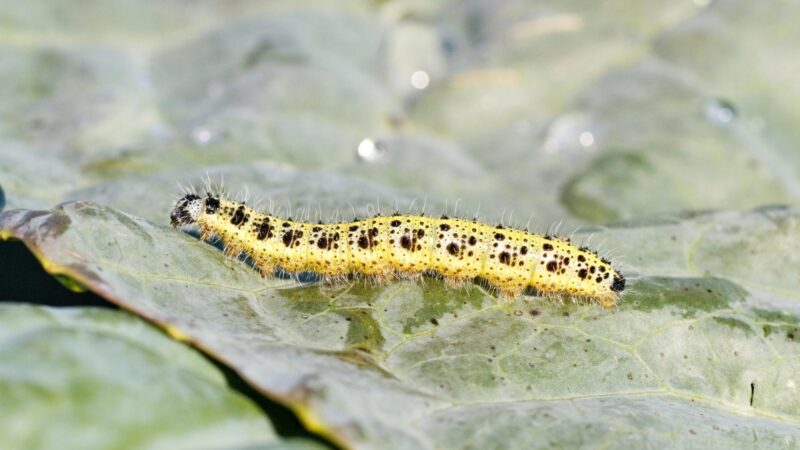
- Scientific Name: Noctuidae
- Appearance: Stout and rough-bodied caterpillars that are dull in coloration and immediately curl into a C-shaped ball when disturbed. Color and markings depending on the species.
- Size: Up to 5 centimeters
- Diet: Foliage, shoots, buds, leaves, and stems of plants such as rice, cabbage, beans, and asparagus. Some species of cutworms, like the black cutworm, feed on nectar.
- Damage: They can cause severe damage to trees, garden plants, shrubs, and vines. They make holes into plants and cut off seedlings or recently transplanted plants above, at, or below the soil line.
- Control:
- Till at least 2 weeks before planting to destroy any plant residues and perform proper weed management since cutworms like to live in weeds.
- Observe a 3 to 4-foot dry soil buffer along the edges of your field to make it look unattractive to cutworms.
- Place a physical barrier, preferably a cardboard collar or aluminum foil around transplants to protect them from cutworm feeding.
How to Get Rid of Cutworms?
Remove the insects with gloved hands and crush or drop them into soapy water to effectively kill them. You can also apply pesticides, although they’re usually not necessary. However, if the infestation is severe, apply them only on areas that are affected since cutworm damage is usually sustained within a field.
Related: How to Get Rid of Cutworms? | The Effective Guide
Whiteflies
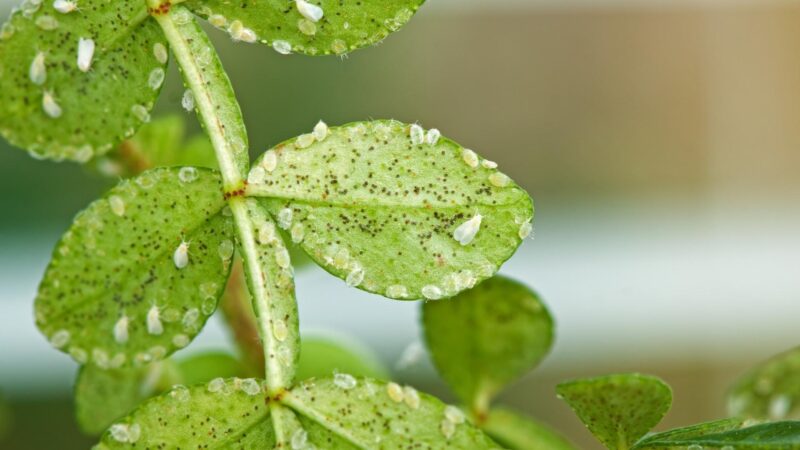
- Scientific Name: Aleyrodidae
- Appearance: They resemble small moths with yellowish bodies and 4 wings that are powdery white. Wing markings vary by species.
- Size: 1.59 to 2.54 millimeters
- Diet: These bugs feed on the plant sap of ornamental plants, such as fuchsia and redbud, as well as vegetables, trees, and woody plants.
- Damage: Plant foliage yellows or wilts once whiteflies feed on them using their sucking mouthparts. Plant death may even occur in severe infestations. Additionally, there will also be a reduction in plant yield, the presence of sooty mold and honeydew, and the emergence of plant viruses, as they are known vectors for them.
- Control:
- Sanitation of fields by removing weeds on and around the vicinity before starting a new crop. Thoroughly check any new plant shipments and stock material by separating them from existing plants and looking for signs of early infestations. Isolation should take 1 to 2 weeks.
- Avoid applying too much fertilizer, and make sure you have a sufficient irrigation system.
- Use of parasitic wasps, such as the commercially available Encarsia formosa and Eretmocerus eremicus, can be purchased and released into your fields to control whitefly populations.
How to Get Rid of Tomato Whiteflies?
Before treatment, use yellow sticky traps to detect the direction of whitefly migrations. Afterward, apply pesticides only in areas that are infested. For example, if there are more populations of whiteflies present at the field margins compared to the field centers, apply the treatment on the field margins instead to reduce costs and help preserve any desirable plants on the field.
Japanese Beetles
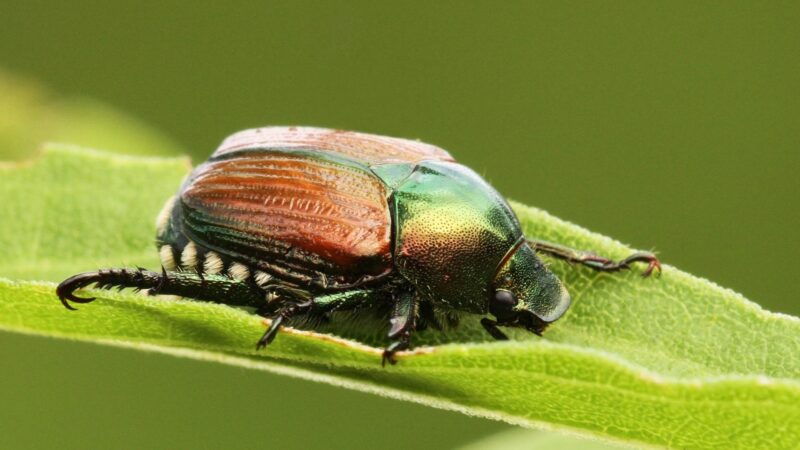
- Scientific Name: Popillia japonica
- Appearance: Metallic body with a green or copper sheen, a hard exoskeleton, chewing mouthparts, and bronze-colored wing covers that have white tufts of hair that extend from under each
- Size: Up to 1.27 centimeters
- Diet: These beetles are serious pests of more than 300 plant species, including flowers, fruits and vegetables, trees, field crops, shrubs, turf, nursery plants, and grasses. They specifically feed on their fruit, flowers, and leaves. Their preferred plants include apples, marigolds, and corn silks.
- Damage: Usually, healthy and mature plants can withstand infestations without any significant injuries. However, unhealthy or young plants can be stunted, damaged, and even killed when infestations are heavy and persistent. For herbs, fruits, and vegetables, plant development and yield can be affected.
- Control:
- Sanitize your yards by removing damaged leaves, as they can attract beetles.
- Apply physical barriers but avoid covering blooming plants that require the help of pollinators, such as fruits.
- If possible, consider planting species that are less preferred by Japanese beetles, such as chrysanthemums, common lilacs, and rhododendrons.
How to Get Rid of Japanese Beetles?
Physically remove the beetles if there are only small populations of beetles present in your gardens. You can do so by handpicking or by placing them inside a container of soapy water to effectively kill them. The use of insecticides can be considered when other control options are not working.
Related: How to Get Rid of Japanese Beetles Naturally? | Identification and Control Guide
Scales
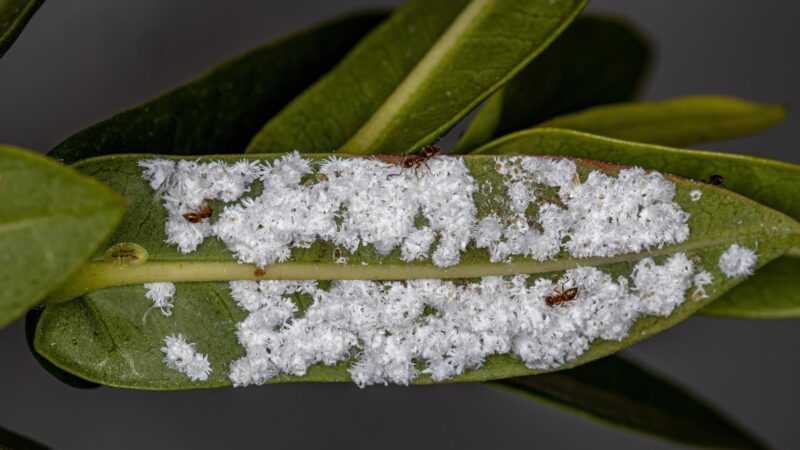
- Scientific Name: Coccoidea (not including mealybugs)
- Appearance: Despite being insects, they usually don’t look like one. They vary in appearance depending on the species, but they all grow a wax covering that covers their bodies. The covering resembles a scale, hence their name.
- Size: 1.59 to 9.53 millimeters
- Diet: They feed on a wide variety of indoor and outdoor herbaceous ornamental plants, shrubs, and trees. Preferred plant hosts include orchids, cottonwood, and hackberry.
- Damage: Damage depends on the scale species. Soft scales, which are a common scale family, feed on plant tissue and then excrete honeydew afterward, which can also cause sooty mold, yellowing leaves, leaf drops, blemishes that are discolored, and a reduction in overall plant health.
- Control:
- Prune plants to improve ventilation and more penetration into denser canopies.
- If possible, choose plants that are less attractive to the insects. Additionally, plant flowering plants near infestations attract their natural enemies, such as parasitic wasps and lady beetles.
- You can apply insect growth regulators to target the insects when they’re in their molting process. Application time depends on species. See this list for the approximate hatch times of scaly bugs.
How to Get Rid of Scales?
Make sure to check the plant if the scales are still alive, as it can be a common occurrence for dead scales to be stuck to their plant hosts even after many seasons have passed. Apply translaminar and systemic insecticides if you have concluded there is an active infestation going on. You can also use horticultural oil as a treatment.
Slugs
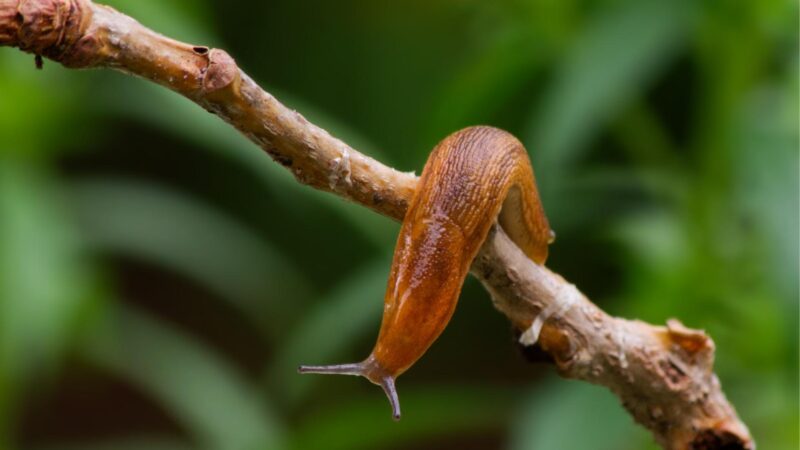
- Scientific Name: Gastropoda (not including snails)
- Appearance: Slugs are primarily made up of water. They have an upper and lower tentacle, modified teeth for grinding food, a respiratory pore called a pneumostome found on their side, a mantle that covers their heads, a foot and a skirt for locomotion, a keel, tail, and slime on their foot.
- Size: 3.5 to 5 centimeters
- Diet: They eat the stems, leaves, roots, debris, and decaying matter of a variety of plant species, such as lilies, strawberries, cabbage, and lettuce. They also feed on earthworms and fungi.
- Damage: Although low to moderate slug feeding does not impact overall plant health, they can still puncture holes through leaves, fruit, and flowers which makes them look unsightly. Severe slug feeding, on the other hand, can cause plant injuries, especially on seedlings. They can also reduce fruit and vegetable harvest.
- Control:
- Prune shrubs and tree branches to create a lighter environment for your plants. Try dividing or thinning them apart to improve ventilation and for soil to dry out faster. On that note, make sure the soil is well-drained.
- You can try planting species that slugs don’t like, such as bleeding hearts, tufted hairgrass, and plantain sedge.
- Purchase copper barriers to deter slugs. You can also try using diatomaceous earth, which is a collection of small fossilized skeletons of old aquatic diatoms.
- Release natural enemies in your fields, such as fireflies, ground beetles, and rove beetles.
How to Get Rid of Slugs?
You can try hand-picking them when there is only a small infestation. Otherwise, you can opt to use chemical baits and apply them in the late afternoon or early evening when the slugs start to emerge. You can use iron phosphate, ferric sodium EDTA, and metaldehyde.
Related: How to Keep Slugs Out of Your Garden Bed? | The Natural Way
Spider Mites
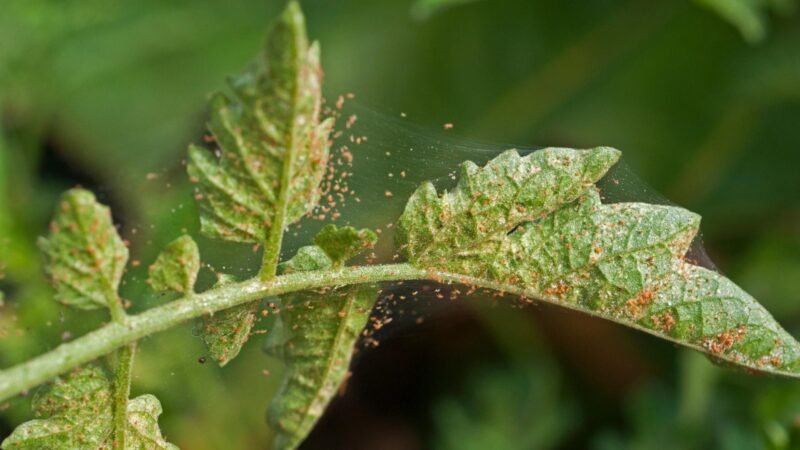
- Scientific Name: Tetranychidae
- Appearance: Tiny, spider-looking creatures whose coloration varies from reddish brown to yellowish green depending on the species and season.
- Size: Up to 0.5 millimeters
- Diet: They feed on the leaves of their plant hosts. Specifically, they remove the contents of plant cells, except for the cell wall. Preferred plants are outdoor plants such as tomatoes, melons, strawberries, and other fruit trees. They also consume shrubs and ornamental flowers.
- Damage: Damage usually appears as light dots on the leaves, sometimes giving them a bronze appearance. As feeding increases, the leaves wilt until they completely fall off the plant. This loss of leaves will impact your next season or year’s crop.
- Control:
- Guarantee that your plant’s environment is not ideal for spider mite development. Do this by making sure your gardening areas are dry, particularly along landscape bed edges and pathways.
- Water your plants sufficiently, especially during drought season, as spider mite damage will be severe on drought-stressed plants.
- Encourage the presence of their natural enemies, such as the Persimilis mite (Phytoseiulus persimilis) and Swirski mite (Amblyseius swirskii).
How to Get Rid of Tomato Spider Mites?
First, try removing spider mites by rinsing them off of your plant leaves. You can do this frequently and at any time of the season, although mid-season is the best time. If this doesn’t work, use a chemical miticide, horticultural oil, or insecticidal soap.
Squash Bugs
- Scientific Name: Anasa tristis
- Appearance: Large insects that have flattened bodies. They are usually mottled dark gray, brown, or black in color. On their abdomens, there are alternating stripes of brown and orange.
- Size: 1.3 to 1.9 centimeters
- Diet: They primarily feed on the leaves, vines, and sap of vegetables such as squash, pumpkins, and cucumbers.
- Damage: When squash bugs feed, they affect the plant’s water flow which can cause nutrient deficiency and wilting when infestations are severe. Other plant injuries include fruit scarring and leaf necrosis.
- Control:
- Maintain your plants’ health by fertilizing and watering adequately. Remove any weeds, as they can attract insects.
- Observe and monitor your crops to be able to detect any early infestations or before infestations become fully established. Examine leaves and look for eggs or newly hatched nymphs on their undersides. They can also be found on the plant base.
- Perform crop rotation to reduce adult squash bugs that are immigrating to your fields.
How to Get Rid of Squash Bugs?
Usually, insecticides are unnecessary for controlling squash bug populations. However, if you need immediate treatment, you can apply them early in the morning or late evening to not disturb any pollinators. Look for insecticides that have acetamiprid, permethrin, malathion, or spinosad. You can also try removing them manually, but it can be a difficult task as they usually hide well under leaves and move quickly when they’re disturbed.
How Do I Keep Bugs From Eating My Plants?
Cultural Control. This type of control refers to modifying the farming or gardening methods adopted by the plant owners. This includes crop rotation, sanitation, trap cropping, and considering the time of planting.
Physical Control. This method involves applying physical barriers to prevent insects from reaching their desired plant hosts. Examples are floating row covers, plant collars, glue board traps, cardboard bands, sunken traps, and chemical lures.
Mechanical Control. Directly removing and/or killing pests is a quick and effective way to stop them from eating your plants. This is usually done by hand-picking and then throwing it into a container of soapy water to effectively kill the insects. Other methods include spraying regular or soapy water and using a swatter.
Biological Control. This is done by releasing the natural predators of the insects you’re trying to control. Farmers and commercial growers will grow certain predators in numbers to significantly reduce pest populations in their fields.
Chemical Control. This involves the use of chemicals to inhibit the insects’ feeding and kill them entirely. Products that can be used are pesticides, insecticides, repellants, irritants, confusants, and synthetic sex pheromones.
What Can I Spray on My Plants to Keep Bugs Away?
Spraying low-impact pesticides are recommended for plant-eating bugs since they usually don’t target their natural enemies and pollinators. You can apply pesticides that are derived from naturally-occurring matter (such as spinosad) and broad-spectrum pesticides (such as carbaryl, permethrin, and bifenthrin).
Plant-eating bug populations can be reduced by applying cultural control, physical control, mechanical control, biological control, or chemical control, depending on the severity of the infestation. In situations that require immediate treatments, pesticides, and insecticides, particularly low-impact, natural, or broad-spectrum products, are usually used to inhibit the feeding or killing of the insects entirely.
List of Sources
Alston, D. (2018). Leafminers of Vegetable Crops. Utah State University.
Alston, D. (2008). Squash Bugs. Utah State University.
Bilberry, S. (2001). Popillia japonica. Animal Diversity Web.
Cranshaw, W. S., Sclar, D. C. (2014). Spider Mites. Colorado State University Extension.
Delahaut, K. (2004). Whiteflies. University of Wisconsin-Madison.
- How to Get Rid of Copperheads | Practical Guide - August 27, 2023
- How to Get Rid of Corn Snakes | What Makes Them Aggressive? - August 27, 2023
- How to Get Rid of Alligators | Safety Measures and Removal Methods - July 16, 2023
